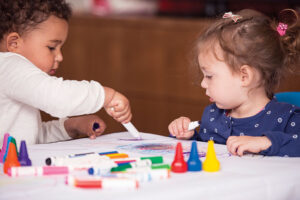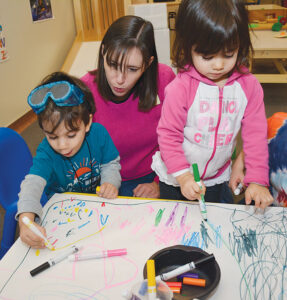Fine motor development
Toddlers use a paintbrush to make marks with water on an outdoor surface.



If possible, take toddlers outside on a warm day to explore putting marks on the sidewalk with a paintbrush and water. Offer a brief demonstration that includes two different types of marks, such as long and short or straight and curved. Explain that we are painting marks with water. The water is our paint. Provide several containers of water if there are logistical problems with one container. Also, have a good supply of water.
Toddlers will enjoy seeing the marks they make with water. Draw attention to the way the water looks on the walk. Example: “We can see where you painted with water. You made a long line with your brush.” Also, emphasize we are using our hands to hold and move the paintbrush. Example: “We are holding a brush with our hands. We are moving the brush with our hands. There is water on our brush that is making marks on the sidewalk.”
Ask toddlers what kind of marks they are making. Offer suggestions if they seem unclear about your question. Example: “Are you making a little mark or a big mark with your brush?”
Toddlers may not be concerned about water evaporation. If a toddler shows interest in not seeing the marks after a couple of minutes, offer a simple explanation, such as “We painted with water. The water mark dried up. They are gone.”
An alternative indoor activity is for toddlers to make marks with wet hands on dark-colored construction paper.
At this age, it is not necessary to teach a specific way to hold the brush. Many toddlers will grip the brush in a fist-type hold. Drawing attention to toddlers’ use of their hands to hold and move the brush helps support awareness of how they use part of their body to grasp and move something. Some toddlers will make broad strokes, whereas others may make dots with water. Generally, toddlers are more interested in the process of making marks and not with the product.
Have a good supply of water. Some toddlers may experiment with dumping the water on the sidewalk.
Extra support
Enrichment
Fine motor development
Toddlers use markers to explore making different kinds of marks (of their choice) on their own piece of paper.




Use the roll of white paper and masking tape to cover a table top. Secure the paper to the table to prevent slipping. This is for table protection. Place on the covered table one sheet of drawing paper per toddler. Provide chubby washable markers. Keep marker lids out of toddlers’ reach.
Invite several toddlers to join you to make marks on their paper. Kneel or sit at the table so you are about eye level to toddlers. Many toddlers will likely be most comfortable standing, but some may wish to have a chair.
Print each child’s name on his/her paper. At this age, toddlers do not learn letters, but you have an opportunity to promote early awareness of the purpose of writing. Explain: “This is your name. This word says ‘Tanya’.”
Encourage toddlers to scribble, go back and forth, or to make lines on the drawing paper. Use a marker to demonstrate scribbling. Describe your actions. Example: “I am scribbling on my paper. My marker goes around and around. Now my marker goes side to side.”
Emphasize we are using our hands to hold and to move a marker. When our marker moves on the paper, it makes a mark.
Talk in a casual manner with toddlers about the scribbles and marks they make.
Example: “There is a lot of color on your paper. You are making marks. You are holding and moving the marker with your hand.”
Toddlers enjoy hearing little stories about themselves. The marker table is a good place to foster communication and language skills. Make marks and recall some ordinary activities from the day. Examples: Make marks on your paper as you tell an arrival story. “Joey, your Daddy drove you to our center today. We said ‘Hi Joey’ and ‘Hi Mr. Toomey.’” Scribble as you recall an outdoor experience, “We played in the grass. We felt the wind blowing.”
 Many toddlers will grip a marker with their whole hand. With experience, toddlers will begin to vary the grip. For this activity, it is not necessary for toddlers to hold markers in a particular way. A pencil grip will be encouraged in most preschool-age settings. Learning to use markers and crayons requires practice and repeated experiences.
Many toddlers will grip a marker with their whole hand. With experience, toddlers will begin to vary the grip. For this activity, it is not necessary for toddlers to hold markers in a particular way. A pencil grip will be encouraged in most preschool-age settings. Learning to use markers and crayons requires practice and repeated experiences.
What’s important in this activity is to support toddlers’ awareness that they are using their hand to hold and move a marker. Moving the marker on the paper leaves a mark.
Some toddlers may put a marker to their mouth. Remind toddlers “Markers go on the paper.”
Extra support
Enrichment
Fine motor development
Toddlers use markers to make marks of their choice on a shared piece of paper.




Be Prepared: Cover the top of a low table with white paper. Tape the ends to prevent it from moving. If toddlers seem interested in your work in taping the paper, describe what you are doing step by step. Toddlers will be interested in your actions and description. Keep the markers out of reach until you are ready to guide the activity. Keep the marker lids in a basket to prevent losing them.
[Invite several toddlers to the table for making a picture together. Help each toddler get a craft apron or smock in place.]
Let’s make a picture together.
[Sit or kneel facing toddlers. Give each toddler one marker. Point to the tip of the marker when you name it.]
This is a marker. Here is the tip. The tip touches the paper. We use our hand to hold the marker and to move the marker on the paper to make marks. Markers make different colors.
We can make a big picture by making marks. We will put our marks on the paper that is on our table.
Would you like me to make marks with you?
[Assuming one or more toddlers say yes, use your marker to scribble in different ways. Make small and large scribbles to initiate toddlers’ work with the markers. Avoid providing a model of what toddlers might draw. Example: do not draw anything the toddlers would recognize, such as an animal, person, or flower.
If a toddler invites you to color with him/her, use a movement to make a mark similar to the toddler’s mark. Mirror the child’s efforts.
 Point out at appropriate times that we are holding a marker in our hand and moving our hand to make marks on our paper.
Point out at appropriate times that we are holding a marker in our hand and moving our hand to make marks on our paper.
Offer positive comments to support toddlers’ efforts. Examples: “You are making marks on our big picture.” “There are different colors on our paper.” “Please tell me about the marks you made.”
Help toddlers notice differences in the marks by pointing to and describing marks without defining shapes. Examples: “This is a short line. This is a longer line.” “There are a lot of blue marks in this part of our picture.”
Rotate kneeling next to each toddler so you can provide individual attention. Point to the marks he/she has made and briefly describe the types of marks the toddler has made or invite the toddler to tell what he/she is doing.
Repeat and extend toddlers’ vocalizations. Example: “Angel, you said ‘Eeeii!’ I think you are excited about using the marker.”
If a toddler motions or offers an ambiguous vocalization, verbalize what you think the toddler wants. Examples: “Mariah, it looks like you want a new marker. Here are two markers. You may take the one you like. You picked a red marker.” “Devon, are you all done? Okay. You used the markers to put colors on the paper. I will help you take your art smock off.”]
Our picture is beautiful! Our picture has many colors and marks. We held markers in our hands and moved our markers to make marks. All of us helped make the picture by making marks. Let’s put our picture on the wall where we can see it. This will remind us of our happy time drawing together.
Some toddlers approach new activities with caution. A toddler may prefer to watch the activity rather than participate. Other toddlers will launch into the activity and eagerly make marks on the paper.
At this age, it is not necessary to teach how to hold a marker. Many toddlers will grip the marker in a fist-type hold. It is helpful to describe the motor aspects of the activity: “We are holding a marker. We are moving a marker to make marks.” Some toddlers will make broad strokes, whereas others will cover a very small area with marks. Avoid prescribing the types of marks toddlers should make, as indicated in the activity description. The toddlers’ grip and type of marks will change with repeated experiences over time. The activity plan invites toddlers to make a picture together, but this is not intended as an orchestrated experience with a predetermined product and assigned roles for what each toddler is to make.
Although color identification is not a goal of the activity, it is helpful to mention the colors of markers and to support children’s comments about the color of their marks. Some toddlers may wish to use a different marker based on color.
Extra support
Enrichment
Materials Needed: Beautiful Oops by Barney Saltzberg, Mouse Paint by Ellen Stoll Walsh, The Artist Who Painted a Blue Horse by Eric Carle, finger paint, freezer bags, tape, non-breakable cups, chubby paintbrushes, and big paper
Along with other books, display the three books listed here. During the week invite one or two toddlers at a time to look at and talk about the pictures in the books with you. Emphasize that the artists used their hands to make the pictures.
Two paint bag doodle tablets can be placed on a low table for toddlers to use to continue making marks. Point out to toddlers that they use their fingers, not a marker, to make marks. Tape the bags so they do not slip.
To Make: Put four tablespoons of finger paint or tempera paint into a freezer zip-top bag. Seal the bag well and move the paint around inside. Smooth the bag out on a flat surface. Tape the bag with paint inside to a low table top. Toddlers may make lines and scribbles by marking on the bag with a finger. The bag can be used many times.
Another day, place small amounts of paint in non-breakable cups for toddlers to use with chubby paintbrushes on big paper.
Materials Needed: drawing tools, such as egg-shaped crayons, chubby crayons, triangle crayons, markers, Magna Doodle®, and paper
Provide tools for different ages of children to use in making lines and scribbles. Infants: Egg-shaped crayons are designed for an infant’s early experiences in making marks on paper. Tape paper to a high chair tray and offer one egg-shaped crayon to an infant. Toddlers: Chubby crayons work well for toddlers. Show children how the color becomes deeper when pressure is applied to the crayon. Preschool-age children: Triangle crayons help preschool-age children develop a grip they will use later with pencils. School-age children: In addition to markers and crayons, older children may enjoy using a magnetic drawing board, such as Magna Doodle®, to make lines, shapes, or letters.